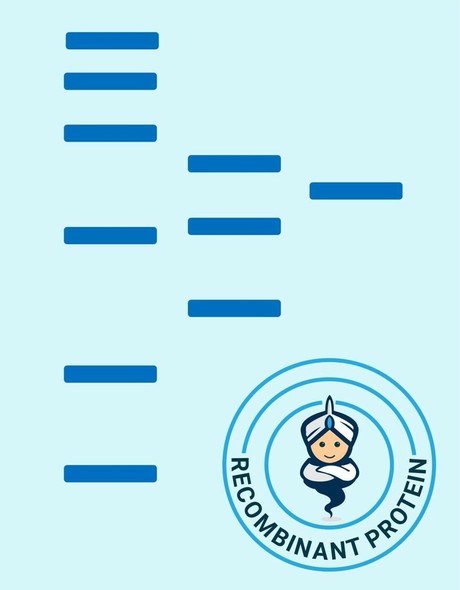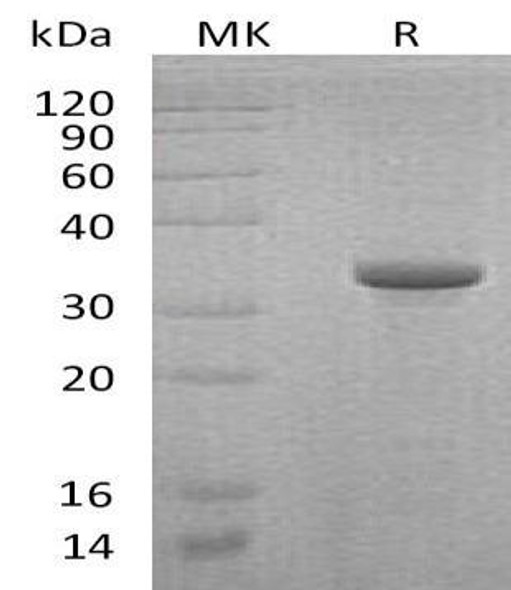Description
| Product Name: | Mouse Endoglin Recombinant Protein |
| Product Code: | RPPB5727 |
| Size: | 10µg |
| Species: | Mouse |
| Target: | Endoglin |
| Synonyms: | CD105, ENG, END, ORW, HHT1, ORW1, FLJ41744, Cell surface MJ7/18 antigen, Endoglin. |
| Source: | Insect Cells |
| Physical Appearance: | Sterile Filtered White lyophilized (freeze-dried) powder. |
| Formulation: | Endoglin was lyophilized from a concentrated (1mg/ml) sterile solution containing no additives. |
| Solubility: | It is recommended to reconstitute the lyophilized CD-105 in sterile PBS not less than 100 �g/ml, which can then be further diluted to other aqueous solutions. |
| Stability: | Lyophilized Endoglin although stable at room temperature for 3 weeks, should be stored desiccated below -18°C. Upon reconstitution CD105 should be stored at 4°C between 2-7 days and for future use below -18°C.For long term storage it is recommended to add a carrier protein (0.1% HSA or BSA).Please prevent freeze-thaw cycles. |
| Purity: | Greater than 95.0% as determined by(a) Analysis by RP-HPLC.(b) Analysis by SDS-PAGE. |
| Amino Acid Sequence: | MDRGVLPLPITLLFVIYSFVPTTGLAERVGCDLQPVDPTRGEVTFTTSQVSEGCVAQAANAVREVHVLFLDFPGMLSHLELTLQASKQNGTETQEVFLVLVSNKNVFVKFQAPEIPLHLAYDSSLVIFQGQPRVNITVLPSLTSRKQILDWAATKGAITSIAALDDPQSIVLQLGQDPKAPFLCLPEAHKDMGATLEWQPRAQTPVQSCRLEGVSGHKEAYILRILPGSEAGPRTVTVMMELSCTSGDAILILHGPPYVSWFIDINHSMQILTTGEYSVKIFPGSKVKGVELPDTPQGLIAEARKLNASIVTSFVELPLVSNVSLRASSCGGVFQTTPAPVVTTPPKDTCSPVLLMSLIQPKCGNQVMTLALNKKHVQTLQCTITGLTFWDSSCQAEDTDDHLVLSSAYSSCGMKVTAHVVSNEVIISFPSGSPPLRKKVQCIDMDSLSFQLGLYLSPHFLQASNTIELGQQAFVQVSVSPLTSEVTVQLDSCHLDLGPEGDMVELIQSRTAKGSCVTLLSPSPEGDPRFSFLLRVYMVPTPTAGTLSCNLALRPSTLSQEVYKTVSMRLNIVSPDLS |
| Biological Activity: | Measured by its ability to bind with rhTGF-beta RII/Fc in a functional ELISA. Optimal dilutions should be determined by each laboratory for each application. |
Endoglin is a type I membrane glycoprotein located on cell surfaces and is part of the TGF beta receptor complex.The protein consists of a homodimer of 180 kDA with disulfide links. It has been found on endothelial cells, activated macrophages, fibroblasts, and smooth muscle cells. Endoglin has been found to be part of the TGF-beta1 receptor complex. It thus may be involved in the binding of TGF-beta1, TGF-beta3, activin-A, BMP-2, and BMP-7. Beside TGF-beta signaling endoglin may have other functions. It has been postulated that endoglin is involved in the cytoskeletal organization affecting cell morphology and migration. Endoglin has a role in the development of the cardiovascular system and in vascular remodeling. Its expression is regulated during heart development . Experimental mice without the endoglin gene die due to cardiovascular abnormalities.
CD105 Mouse Recombinant extracellular domain produced in baculovirus is a homodimeric, glycosylated, Polypeptide containing 581 amino acids and having a molecular mass of 61 kDa but as a result of glycosylation, migrates at 75-85 kDa under reducing conditions in SDS-PAGE. Based on N-terminal sequenceanalysis, the primary structure of recombinant mature Endoglin starts at Glu 26.The CD105 is fused to a C-terminal His-tag (6xHis) and purified by proprietary chromatographic techniques.
| UniProt Protein Function: | ENG: Major glycoprotein of vascular endothelium. May play a critical role in the binding of endothelial cells to integrins and/or other RGD receptors. Homodimer that forms an heteromeric complex with the signaling receptors for transforming growth factor-beta: TGFBR1 and/or TGFBR2. It is able to bind TGF-beta 1, and 3 efficiently and TGF-beta 2 less efficiently. Interacts with TCTEX1D4. Interacts with ARRB2. Endoglin is restricted to endothelial cells in all tissues except bone marrow. 2 isoforms of the human protein are produced by alternative splicing. |
| UniProt Protein Details: | Protein type:Membrane protein, integral; Motility/polarity/chemotaxis; Receptor, misc. Chromosomal Location of Human Ortholog: 2 B|2 22.09 cM Cellular Component: cell surface; cytoplasm; external side of plasma membrane; extracellular space; focal adhesion; nucleoplasm; receptor complex Molecular Function:galactose binding; glycosaminoglycan binding; protein binding; protein homodimerization activity; punt binding; transforming growth factor beta binding; transforming growth factor beta receptor, cytoplasmic mediator activity Biological Process: angiogenesis; artery morphogenesis; atrial cardiac muscle morphogenesis; central nervous system vasculogenesis; chronological cell aging; heart development; heart looping; negative regulation of cell migration; negative regulation of protein amino acid autophosphorylation; patterning of blood vessels; positive regulation of angiogenesis; positive regulation of BMP signaling pathway; positive regulation of collagen biosynthetic process; positive regulation of protein amino acid phosphorylation; positive regulation of transcription from RNA polymerase II promoter; regulation of transcription, DNA-dependent; regulation of transforming growth factor beta receptor signaling pathway; smooth muscle development; sprouting angiogenesis; transforming growth factor beta receptor signaling pathway; vasculogenesis; venous blood vessel morphogenesis |
| UniProt Code: | Q63961 |
| NCBI GenInfo Identifier: | 341940479 |
| NCBI Gene ID: | 13805 |
| NCBI Accession: | Q63961.2 |
| UniProt Secondary Accession: | Q63961,Q61520, Q8K100, |
| UniProt Related Accession: | Q63961 |
| Molecular Weight: | 70,021 Da |
| NCBI Full Name: | Endoglin |
| NCBI Synonym Full Names: | endoglin |
| NCBI Official Symbol: | Eng�� |
| NCBI Official Synonym Symbols: | Endo; CD105; AI528660; AI662476; S-endoglin�� |
| NCBI Protein Information: | endoglin |
| UniProt Protein Name: | Endoglin |
| UniProt Synonym Protein Names: | Cell surface MJ7/18 antigen; CD_antigen: CD105 |
| UniProt Gene Name: | Eng�� |








